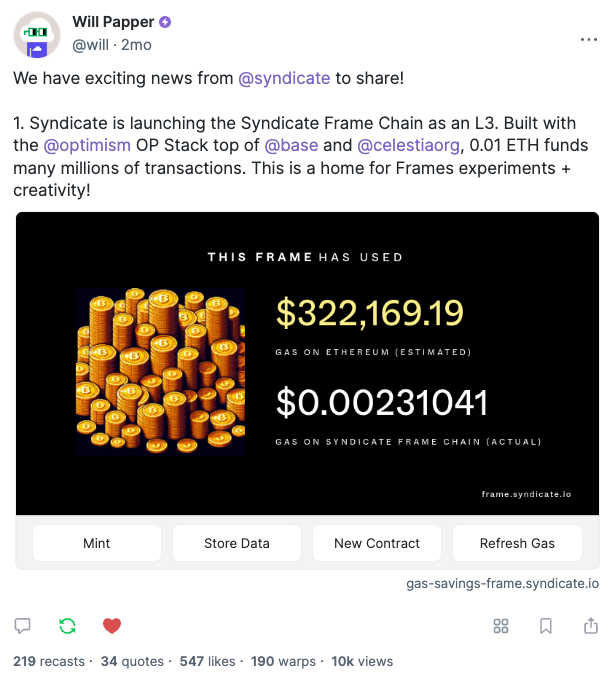Gas Costs on L3s Are a Millionth of a Penny
Two months ago, our team decided to run an experiment by launching an L3 for Farcaster Frame developers. It was one of the world's first modular L3s using the OP Stack, Base for settlement, and Celestia for data availability.

Two months ago, our team decided to run an experiment by launching an L3 for Farcaster Frame developers. It was one of the world's first modular L3s using the OP Stack, Base for settlement, and Celestia for data availability. Our goal was to lower gas fees for Frame developers to encourage larger-scale experimentation with Farcaster Frames, which were just starting to take off at the time. We also wanted to see if L3s might be suitable one day for larger projects like Nike .SWOOSH that is powered by our infrastructure.
Our hope was that the L3 could reduce gas costs by 10x. 100x? That would be incredible. But we had no idea what would actually happen once live. There were few real world precedents at the time—we even thought that gas costs could end up higher on the L3 than an existing L2. But after we launched, the data started coming in.
$0.00000001 (one millionth of a penny).
“That has to be wrong. Can you check what’s the problem?”
“That’s right? No way…”
“omg 🤯”
These were the messages in our team Slack. As the L3 grew and handled hundreds of thousands of transactions, gas costs were still a millionth of a penny—sometimes even lower. That’s when we knew we had opened Pandora’s box. The possibilities unlocked by L3s with near zero gas costs were endless.
Several pioneering teams like Gold and Degen—who were already planning L3s of their own—saw our L3 experiment on Farcaster and reached out to work with us. Since then, we’ve helped them launch Gold Chain and Degen Chain over the last month—and we’re working on PengChain, HAM Chain, and many more.
While L3s with near zero gas costs are a game changer, most don’t realize it yet. Many are still catching up with the concept of modular blockchains, let alone L3s. But our team has been pushing the boundaries of modular L3s at scale with leading projects and their developer ecosystems over the last two months, and we’re still just scratching the surface of how L3s will significantly reshape the industry.
A New Era of Modular L3s with Near Zero Gas Costs
Gas costs as low as a millionth of a penny weren’t possible until just a few months ago. Modular blockchains with alternative execution stacks, settlement, and data availability layers came online earlier this year, enabling an OP or Arbitrum Stack blockchain like Gold Chain and Degen Chain to settle to Base and use Celestia or AnyTrust for data availability rather than Ethereum.
Data availability alone can account for over 80%+ of gas costs. As a result, modular blockchains—whether an L2 or L3—using alternative data availability layers like Celestia have significantly lower network fees. Additionally, bridging assets from an L2 like Base to an L3 like Degen Chain is a lot cheaper for users than bridging from Ethereum L1 to Base L2. And finally, some data is still written to the underlying settlement chain, which is cheaper as an L3 writing to an L2 than an L2 writing to Ethereum L1.
How big is the difference in gas costs?

Syndicate’s Co-Founder, Will Papper, shared the Farcaster Frame above demonstrating the difference in gas costs between Ethereum L1 and the L3 we launched. By clicking buttons in the Frame, it mints NFTs, writes data, and deploys smart contracts onchain. In the tens of thousands of times Will’s Frame has been clicked to date, the Frame would have consumed over $300,000 in gas on Ethereum L1 (!) alone, but on the L3, the Frame has only spent two-tenths of a penny on the L3 in total (!!).
That’s over 100,000,000x less in gas costs (!!!).
1000x+ Lower Cost. 1000x+ New Possibilities.
When we can reduce gas costs by this magnitude—to near zero—via L3s, it dramatically lowers the barriers for new experimentation at scales previously unimaginable.
Startups can now realistically subsidize all onchain transactions for all users of their app. Companies can airdrop NFTs to hundreds of millions of consumers on a regular basis. Developers can build new social, gaming, and consumer experiences where every single interaction is recorded onchain that can be composed with new applications. Data that was previously kept off-chain due to cost concerns can now be put onchain.
This opens an entirely new design space for web3 applications, games, and platforms.
The Coming Wave of L3s
As L2s grow in popularity but ultimately reach practical scaling and efficiency limitations, it’s inevitable that many L3s will emerge for every community, application, game, and platform. Even with EIP-4844 blobs, which resulted in an impressive 10-100x reduction in L2 gas costs, L3s are still over 100,000x+ cheaper. L3s won’t replace L2s (L2s have important advantages and play a very critical role in the system), but L3s will grow exponentially in the coming years, and they’ll play a big role in scaling Ethereum, empowering onchain communities and their applications, and onboarding hundreds of millions of new users into web3.
The design space and opportunity to innovate in L3s for onchain communities and applications is wide open—if you’re considering an L3, we invite you to join us and a growing number of pioneering communities and teams in this space. Reach out to us today here.